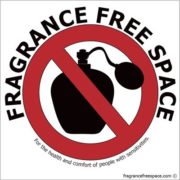Scent-Free Care Home and Workplace
Menno Place team members are expected to be scent-free in the workplace and in our resident’s homes. This is a reminder to examine yourself to ensure that you are scent-free at work.
What is meant by scent-free?
When we talk about scents, we usually mean the smells or odours from cosmetics (perfume, make-up, shampoo, deodorant, etc.) or from other products such as air fresheners, cleaners, etc.
Unfortunately, there is no exact definition for scent-free, fragrance-free or unscented. Products labelled as unscented may actually contain ingredients that are used to mask or hide the smell of other ingredients. However, certain product composition statements are required, including:
Odour or fragrance
If a product formulation has been amended to add or change a fragrance, terms such as “fresh scent,” “floral scent” or “lemon scent” that describe the resulting odour may be added by notification. The terms “fragrance-free” or “unscented” may be added by notification if the product is odourless or nearly odourless, and contains no odour-masking ingredients such as a perfume. The term “de-scented” may be added if the product contains an odour-masking ingredient.
(Source: Regulatory Directive DIR2013-02, Notification/Non-notification. Health Canada)
While it is important to be aware of the lack of consistency when these terms are used by various manufacturers, the terms can still be a rough guideline when choosing products.
Can scents cause health problems?
When scented products have been blamed for adversely affecting a person’s health, some or all of the following symptoms are reported:
- headaches
- dizziness, lightheadedness
- nausea
- fatigue
- weakness
- insomnia
- malaise
- confusion
- loss of appetite
- depression
- anxiety
- numbness
- upper respiratory symptoms
- shortness of breath
- difficulty with concentration
- skin irritation
Allergic and asthmatic patients, as well as those with other conditions, report that certain odours, even in the smallest amounts, can trigger an attack.
The severity of these symptoms can vary. Some people report mild irritation while others are incapacitated and/or must give up many ‘normal’ activities in order to avoid exposure (such as going to public places).
These reactions can be known as a condition called environmental sensitivities. According to the Women’s College Hospital:
“Environmental sensitivities (ES) describes a chronic condition whereby a person has symptoms when exposed to certain chemicals or other environmental agents at low levels tolerated by most people. The symptoms may range in severity from mild to debilitating.
ES has also been called multiple chemical sensitivity, chemical intolerance, environmental hypersensitivity, environmental illness, toxicant-induced loss of tolerance, and idiopathic environmental intolerance.”
What types of products contain scents?
Scents are included in a very large range of products including:
- shampoo and conditioners
- hairsprays
- deodorants
- colognes and aftershaves
- fragrances and perfumes
- lotions and creams
- potpourri
- industrial and household chemicals
- soaps
- cosmetics
- air fresheners and deodorizers
- oils
- candles
- diapers
- some types of garbage bags
- laundry detergent, fabric softener and in-wash scent booster pearls
It is important to remember some products which claim to be ‘scent free’ may have only masked the scent by use of an additional chemical. Be sure to research the product carefully if using scented products around those who are sensitive.
What other types of scents can enter our resident’s homes?
Be aware of plants / flowers that are fragrant and don’t bring them into our residents homes.
Some examples of fragrant flowers that are highly scented are:
- Hyacinths
- Freesias
- Lavender
- Lilacs
- Some varieties of Lilies
- Sweat Peas
- Roses





